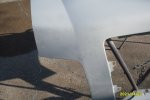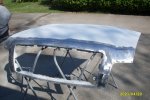Do you realize that Single Stage Urethane and (Poly) Urethane clears are very closely related? So essentially what is true for one is true for the other.
That's true! I've heard that before, and that is why clear coat over single stage won't delaminate in the same way. I've always believed clear coat is essentially single stage urethane with no pigment. It drys in the same way single stage products do. In essence, clear coat is essentially no different from single stage.
You have to apply more clear than you need if you are cutting and buffing. (Just as you would have to apply more SS than you need if you cut and buff) Done correctly it will last for decades (assuming you are using quality products). Once a clear is cut and buffed unless it's abused there is no need for any further cutting nor any heavy buffing. Any maintenance type buffing done after the initial cut and buff, will only remove a negligible amount of material and is not an issue provided enough clear was applied initially. Where it is an issue is when not enough clear was applied and then an excessive amount of cutting and buffing was done. The same would hold true for a Single stage.
That's very true as well that you say. In fact I would say, most drivers on the road have no use for single stage. It depends on your definition of
longevity. Most drivers on the road would rather have a low maintenance and durable finish that doesn't fade. Most drivers on the road are not constantly buffing. My big issue is this.
I have found that clear coat is more prone to scratching. The only way to get scratches out of clear is by wet sanding. Buffing only goes so far. Again for most these scratches are unnoticeable, but for a show car where you want a pristine finish then it will annoy you to the hilt. I have found it much easier to use car covers over single stage finishes. As soon as I put a cover over clear coat I notice scratches immediately no matter how soft it is. I have found that single stage finishes are more durable, in that they are less prone to scratching. That is why they say that single stage urethanes and lacquer have greater depth. Clear dulls overtime, and so does single stage as it fades. The difference being that it's easier to buff single stage than clear. With clear you can only go so far. Also of course if you store a show car in the garage it will take a lot longer to fade, and especially the urethane single stage products they have out now. I think I'm in agreement with everything you say.
Single Stage Urethanes that are blended within a panel are much harder to repair than a BC/CC. And once repaired they are flawed, in that the edges of the repair are very thin and will eventually fail. There is no getting around that if you do a within the panel blend on single stage. BC/CC are much easier to repair and and because the blend panel is fully cleared will last as long as the rest of the job. No one blends Single Stage unless they have absolutely no choice. Just like no Pro will blend clear within a panel on anything but a the lowest level type repairs. The edge will eventually fail.
So again I will say, I believe it depends on the definition of
repair. To clarify, I believe the process of painting single stage and clear are in essence no different. When I was talking about making blends in the repair I was more explaining that it's easier to make repairs on lacquer. I believe a proper repair would be repainting the entire panel no matter what. A spot repair will only take you so far. On a show car I would never feel comfortable making spot repairs.
Now, the difference with single stage urethane and bc/cc would be this. Any repair involves going back to primer, applying new base, and clear. With single stage you can just paint over a new coat. You cannot really sand or work with base, as easily as you can sand single stage. Now for all practical purposes, not including metallics which is a whole separate debate. Personally I would rather work with restoring single stage every time. You could take a 50 year old paint job, sand it with 400 grit and add on a new coat. The scratches will fill in. The chemical structure of single stage will never fail in that sense like clear delaminates from base. Once clear begins delaminating you are taking it back to primer. I believe single stage can outlast in that regard.
I have no idea what you are talking about here. Explain please. A quality Siphon feed gun will spray clear fine. It will simply use much more material and put out much more overspray. Those two things are the main reasons siphons are no longer used.
So I have been in discussion with a lot of old timers, and I asked them if there was anything they liked about siphon feed guns. They told me that the nature of HVLP guns introduces more orange peel. Like you said above, it's actually more difficult to paint single stage and get a good finish. Perhaps it takes a lot more skill in many instances, because what's coming out of your gun will be your final finish. There is no clear.
I've been told by a few folks that with single stage, you will get a lot less orange peel with a siphon. I'm not sure why that is but I'm sure there is a reason if I look into it. Probably related to air pressure. Now with bc/cc, increased orange peel actually works to the advantage of modern paints, because the more orange peel you have the more UV protection your finish will obtain. When you buff and wet sand orange peel away on clear which most classic restoration shops do, you are reducing the life expectancy of your show car. That is why sanding the factory finish voids the warranty. With single stage it is a completely different ballgame.
Now when it comes to metallics that is another topic entirely. I have been told before that when you are painting single stage metallic, you want to use a siphon feed because HVLP guns don't have the pressure necessary to push out metallic flakes. You will get a much better finish out of a siphon, and in some cases this applies to solid colors as well because gravity feed guns can clog. The words used to describe it to me were, they have a tendency to bottleneck like a ketchup bottle and this is especially true with metallics. Not really a problem if you're using base and then you'll be clearing over it, but you're not going to get an even flow or finish with a gravity feed and HVLP will not be enough pressure. The point of me explaining that was to showcase how the standards the industry has adopted is saving on material and costs, and not necessarily to produce better jobs. In other words, you can get as good of a job if not a better job using a siphon feed in the hands of a professional. You're just going to waste more material.
Of course I don't mean to say it's not possible to get a good finish out of an HVLP, and I think we would agree that any gun in the hand of a competent painter can produce good results. It further proves my point, that the guns we used in the past are just as good as the guns we use today in my opinion and the opinion from many I talk with. I was really approaching this debate asking the question, have we really improved? Is it possible to lay down amazing paint jobs with older techniques? This is all really my opinion, and I don't really see it being talked about a lot and it's a little controversial. I understand it's not a very popular one, but since I left insurance work I will never touch another base coat product again and especially the tragic water based that are flooding the market.




